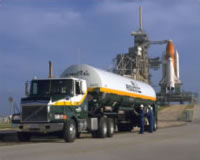
![]()
In the case of on-board storage of hydrogen for vehicular applications, automobile manufacturers require lightweight, compact, safe, and cost-effective storage plus the ability to achieve a driving range of at least 300 miles. The 300-mile driving range requires 5-10 kg of usable hydrogen depending upon the size of the vehicle. Although various hydrogen storage technologies are presently available, none completely satisfies all of the auto industry requirements. In fact, finding a solution to the hydrogen storage problem is considered by many to be the foremost challenge for the hydrogen economy.
 |
| Air Products LH2 tanker with Shuttle Atlantis (Photo: Air Products) |
|---|
- As a compressed gas in high-pressure tanks.
- As a liquid in dewars or tanks (stored at -253°C).
- As a solid by either absorbing or reacting with metals or chemical compounds or storing in an alternative chemical form.
Issues include operating pressure and temperature; the life span of the storage material (stability); the requirements for hydrogen purity imposed by the fuel cell; the reversibility of hydrogen uptake and release; the refueling conditions of rate and time; the hydrogen delivery pressure; overall safety, toxicity, and system-efficiency and cost. No material available today comes close to meeting all the requirements for onboard storage of hydrogen for fueling a fuel cell/electric vehicle.
 |
| Experimental test bed for evaluation of zero-boil-off cryogenic sys, FSEC H2 Lab, J. Baik (Photo: N. Waters) |
|---|
These requirements are often contradictory to each other (like the need for high specific energy and high energy density), and the requirement to simultaneously address these issues adds to the magnitude of the challenge. In fact, some of the requirements for onboard hydrogen storage seem unattainable especially with gaseous or liquid methods.
Storage of hydrogen in chemical compounds offers a much wider range of possibilities to meet the transportation requirements, but no single material investigated to date exhibits all the necessary properties. The storage solution requires breakthroughs in materials performance that can only come from innovative and basic research that looks beyond the materials considered, to date. The exacting demands on storage capacity, charge and discharge conditions, stability, and cost span the traditional disciplines of chemistry, physics, materials science and engineering. The fundamental factors that control bond strength, desorption kinetics, degradation due to cycling, and the role of nanosize and nanostructure in bonding and kinetics must be researched and new materials found.
At present, only three systems for on-board hydrogen storage are close to commercialization. They are compressed gas at high pressures (5,000 to 10,000 psi in composite cylinders), liquid hydrogen which requires a cryogenic temperature of -253 ° C, and materials-based storage in solids which involves the use of metal hydrides, carbon-based materials/high surface area sorbents, and/or chemical hydrogen storage.
The current status of various storage technologies in terms of weight, volume and costs is given below. These systems show a three to eight times performance gap in meeting the DOE goals.
|
